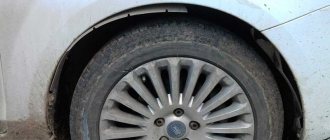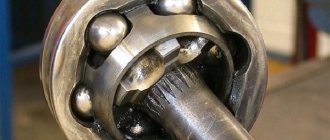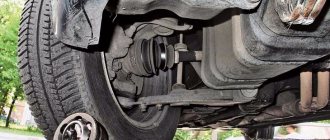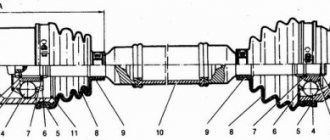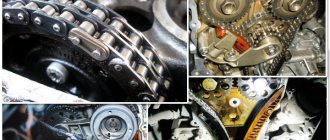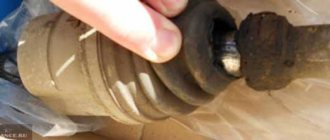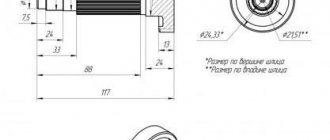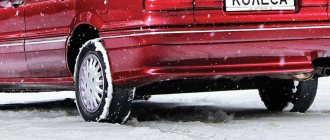The drives of the steered wheels of a car are a combination of two constant velocity joints (CV joints) connected by a shaft with splined ends. Strictly speaking, a similar design is found in the rear drive axle with a gearbox in a separate housing, but diagnostics are much more often required by the front drive, which operates in more severe conditions in terms of torque transmission angles.
The process of determining which of the four CV joints working there is worn out or has begun to deteriorate is usually difficult and requires adherence to a precise methodology in order to avoid wasted time and money.
A little theory
CV joints (constant velocity joints) perform one single, but very important task, namely the transmission of torque at rotation angles of up to 70 degrees relative to the axis.
CV joints are used only in all-wheel drive and front-wheel drive vehicles to ensure the front wheels turn and rotate under load.
CV joints are divided into:
- Internal
-
transmit torque from the gearbox to the drive shaft. - External
-
transmit torque directly to the wheels.
I will not analyze in detail the structure of CV joints, since the article will turn out to be too long and tedious, and you decided to read it only in order to find out how to carry out a quick and effective diagnosis. Therefore, I will simply advise you to check the CV boots more often, since some manufacturers themselves say that generally CV joints only have to be changed when the boot breaks.
Well, now let's get straight to the point.
Types of CV joints, their design features
The most common types of CV joints in the design of front-wheel drive passenger cars are ball and tripoid.
The former are often used on the outside, the latter as internal hinges. On some models, ball devices may also be installed exclusively.
The design of these types of CV joints differs, and significantly. The tripoid assembly consists of an outer casing of a certain shape, on which there is a drive shaft end stop (thanks to it, the drive is connected to the gearbox).
The housing contains a tripoid with rollers, mounted via a splined connection on the drive shaft.
Ball CV joints are partially similar in design to conventional bearings - there are two cages between which the balls are located in the separator.
The outer ring of the unit is its body, on which another shaft end is attached (it is installed in the wheel hub). The inner race is mounted on the drive shaft by means of a spline connection.
The transfer of force from the inner race to the outer one in such a hinge is carried out by balls, which are located in special grooves on the working surfaces of the races.
These same grooves allow the balls to move longitudinally, thereby ensuring transmission of rotation when the drive shaft and end switch are positioned at an angle relative to each other.
A tripoid CV joint is structurally simpler, and therefore more reliable, but it is used only as an internal hinge. This is due to its operational characteristics - they allow significant longitudinal movements of the tripoid relative to the body (provides a change in the length of the drive), but at the same time it is limited in the angle of rotation of the limit switch relative to the shaft.
In ball joints, the angle of rotation is much larger, so it is better suited for use on the outside of the drive, but such a unit does not provide significant longitudinal movements.
Due to their more complex design, very harsh operating conditions and location (near the wheel), ball CV joints are more susceptible to wear and malfunction; they are smaller in size than their tripod counterparts.
Both types of CV joints are made with high precision, so there are no backlashes in them. But during the operation of the car, the working surfaces of the hinge gradually wear out, which leads to the appearance of backlashes, which are the main cause of unit failure. The wear situation is aggravated by dirt getting inside the joint.
As already noted, CV joints are quite reliable and can last a significant period of time, provided they are used correctly. These hinges are very sensitive to dirt. Dust and sand trapped inside the unit act as an abrasive, significantly accelerating the wear of working surfaces.
Anthers are used to protect the hinges from dirt. But these rubber elements are the “weak point” of CV joints.
Rubber tears relatively easily; it is affected by the environment, leading to “aging” and cracking of the material. The anthers of the external hinges are especially susceptible to negative influences.
Why does the CV joint crunch?
The CV joint produces extraneous sounds when worn. A wear appears on the CV joint cage and bites the balls when moving. The crunch comes from the trial.
Most often, a grenade (CV joint) fails due to a damaged CV boot, rather than due to natural wear.
That is why it is necessary to check the condition of the anthers at least twice a year.
If you find that the CV boot is torn, then you need to wash the CV joint, lubricate it and install a new boot.
Sounds and symptoms of breakdown
There are several signs of a hinge failure:
- Anther rupture. It is enough to go to a service station, where the faulty element will be replaced, and the need to repair the CV joint itself will disappear.
- The sound of a grenade. The sound is very reminiscent of the friction of brake pads worn down to metal.
- Jerks. When the car starts moving, the driver may feel slight shocks. This behavior indicates broken grenade grooves.
- Clicks. They appear at the moment of movement, and their number varies from 2 to 5. When moving, the unpleasant sound disappears, but the next time you try to move, it appears again. This also indicates a malfunction of the grenade.
- Crunch. If the sound appears directly when moving, then this is an alarming signal. The CV joint is not only worn out, it is about to seize. Driving with such damage is dangerous, so it is best to call a tow truck and send the car to a workshop.
If at least one of the listed symptoms of a malfunction appears, then it is better to send the car for diagnostics. Experienced drivers can inspect the joint themselves and identify the source of the problem.
A little about the nature of the problem
A CV joint is necessary to transmit rotation between the axle shafts with a constant change in the angle between them. The part is used in front-wheel drive and all-wheel drive vehicles. The drive wheel in such cars must not only rotate, but also turn, and also lower and rise on a spring. Such hinges allow you to do all this.
The design of this unit consists of three main components:
- The outer housing, which is made in the shape of a bowl and is connected to the axle shaft.
- Inner ring. It has a spherical shape. There are six grooves on it, thanks to which the clip is attached to the outer casing.
- Six small balls in the separator. They are located between the bowl holder and the machines.
The problem is that during operation, with the constant “walking” of the balls in the structure, wear and small scuffs form. The movement of the balls becomes more free, which leads to a characteristic sound. Even inexperienced drivers will be able to determine the presence of this problem. You may hear clicking sounds accompanied by vibration or whistling. In most cases, the sound will resemble the crunching of metal.
Reasons for appearance
Before we talk about how to determine which CV joint is crunching, it is necessary to find out the most common causes of this problem. Correct diagnosis greatly simplifies repairs. The key reasons for this phenomenon include:
- Defective part. At a car service center, you could have had a CV joint installed that was not made to the standards, which is why there were gaps from the factory. In this situation, the best solution would be to completely replace the CV joint.
- Lack or insufficient amount of granite lubricant. It is recommended to replenish it to the required volume.
- Severe wear on the anthers. During operation, these components lose their elasticity, which is why sand, dirt, water and dust get into the hinge structure. All of them lead to the appearance of a specific crunch.
- Aggressive driving style. In such situations, a very large load is placed on the hinges, which significantly reduces their service life. With constantly aggressive driving, the crunch will not take long to occur.
Is the CV joint really to blame?
As soon as you hear a crunching sound in your car, you should not draw any clear conclusions, because the source may be some other component. The involvement of constant velocity joints can be determined in two ways.
Turn the wheels of your car all the way to the side, and then try to drive off in this position. If in this particular situation a crunching sound is heard, then the problem is really in the hinges. This problem can also occur when overcoming small obstacles, for example, potholes on a country road. There will be increased stress on the CV joints and you should hear crunching sounds.
How to find out which CV joint has worn out?
Since four parts are used on a car at once, the question arises of how to find out which “grenade” needs to be replaced.
The failure of external CV joints is determined using a simple test. To do this, park the car on a level and fairly large area and start the engine. Turn the steering wheel to maximum speed in one direction. Try to move off as quickly as possible, with slight slippage allowed. If you hear a characteristic crunch, then the malfunction lies in the external “grenade” on the side that you turned the steering wheel.
Diagnosis of internal hinges is much more difficult. To do this, select a ditch of such depth that the wheel can freely go there to the maximum depth, but do not choose too deep, otherwise there is a risk of damaging the suspension parts. After this, at a certain angle to the ditch, overcome it, trying to keep the steering wheel straight and without making any turns. The wheels should fit evenly and one by one into the recess. The appearance of crunching sounds indicates a malfunction of the internal CV joint. The side of the faulty mechanism corresponds to the wheel whose characteristic sound appeared after entering the ditch.
These basic diagnostic methods began to be used with experience. They allow you to determine with maximum accuracy the source of the sound and the nature of the malfunction. However, there are a number of other methods that involve, first, disassembling the hub and after that the CV joint is pulled towards itself, then towards itself, then in the opposite direction. The appearance of backlash or knocking also indicates that the “grenade” needs to be replaced.
It is worth noting once again that if the above signs of malfunctions are detected, it is necessary to proceed to replacing the unit. Since the CV joint is a consumable, non-repairable mechanism.
Universal diagnostic method
Diagnosis of a malfunction of the internal CV joint
We present to you an algorithm for another, universal option, how to find out which “grenade” is crunchy. You need to act in the following sequence:
- Place the car wheels level.
- Raise one of the front wheels using a jack.
- Put the car on the handbrake and neutral gear.
- Start the engine, depress the clutch, engage first gear and slowly release the clutch, that is, “move off” (as a result, the suspended wheel will begin to rotate).
- Slowly press the brake pedal, creating a natural load on the joint. If one of the internal “grenades” is faulty, then at this time you will hear familiar knocking sounds on the left or right side. If the internal CV joints are in order, then the car will simply start to stall.
- Turn the steering wheel all the way to the left. Slowly press the brake pedal. If the internal “grenade” is faulty, it will continue to knock. If the outer left CV joint is also faulty, then sound will also be added from it.
- Turn the steering wheel all the way to the right. Carry out similar procedures. If a knocking noise occurs when the steering wheel is turned to the right, it means that the right outer joint is faulty.
- Be sure to put the gear in neutral, turn off the engine, and wait until the wheel comes to a complete stop before lowering it to the ground.
Signs of malfunction when turning and accelerating
Symptoms of malfunctioning external and internal hinges manifest themselves in different ways.
It is quite simple to determine the wear of the outer CV joint by the characteristic crunch when turning, which appears when you start driving with the wheels fully turned, especially when starting at high engine speeds.
Additionally, vibration may occur on the steering wheel. When the wheels are aligned, the sound disappears. This is all due to the peculiarities of the operation of the hinges - as the angle between the shaft and the limit switch increases, the load on the CV joint increases, and if there are backlashes in it due to wear, then they lead to a crunch in the unit.
Internal hinges do not work at such significant angles as external ones, so they do not always make a crunching sound, which complicates their diagnosis.
Malfunction of CV joints installed near the gearbox often manifests itself in the form of vibrations and knocking in the front suspension when the car moves over uneven surfaces. Moreover, the more unevenness (deep holes, strong bumps), the stronger the knocks.
In some cases, symptoms of a faulty inner joint appear even when driving on a flat and straight stretch of road when accelerating to 100 km/h or above.
Checking the internal grenade
When checking the internal hinge while moving, it is also necessary to create the worst operating conditions for it, that is, maximum angles. Nothing depends on turning the steering wheel, so you will need to tilt the car as much as possible, moving in an arc at high speed under full traction.
A crunch from the inside of the car relative to the trajectory will mean wear of the internal joint on this particular drive. The opposite side, on the contrary, will reduce the angle of the fracture, so a crunch there can only appear from a node that is in a completely critical condition.
A test on a lift can be constructed in approximately the same way, loading the drive with brakes, and changing the angles of the suspension arms using hydraulic supports. At the same time, it’s quite easy to assess the presence of gaps and the condition of the covers. Long torn boots with dirt and rust inside will mean that the hinge must definitely be replaced.
How to find out which CV joint is crunching
Each wheel has two hinges: internal and external. This significantly complicates the diagnostic process, since they are located next to each other, so it is almost impossible to determine by ear which of the components makes sounds. A few tips will help you find out which CV joint is crunching (internal or external):
- Turn off the vehicle, and then use a flashlight to locate the hinge pins. Pull them one at a time without applying much force. If no play is detected, then the part is fully operational. If a large amount of wear occurs, your actions will lead to a crunching sound, which will help diagnose the failure of a particular hinge.
- The second method allows you to diagnose a breakdown of the external hinge. You need to drive onto a flat road, and then turn the wheels to the side until they stop. If at this moment you hear a characteristic sound, then the problem is in the internal CV joint. The left part is worn out when there is a sound when turning right. With the right part there will be a sound when turning left. This is due to the fact that when turning, the entire weight of the car falls on the opposite side of the turn.
Causes of CV joint failure
- natural wear and tear of the part
- factory defects, low quality metal
- violation of the rules for installing CV joints
- lack/absence of graphite lubricant
- damaged boot, dirt and moisture trapped inside
- aggressive driving, driving with the wheels turned out at speed
- poor road surface
- severe impact - accident, collision with a curb, etc. damage to the suspension
If the CV joint fails, the owner hears characteristic clicking and crunching noises when the wheels are turned all the way. For example, while parking. But since each wheel has two joints, it is important to find out which CV joint has failed: external or internal, right or left?
Checking the outer CV joint
Diagnosis of a faulty CV joint begins with checking the external “grenades”. Let's look at the signs of wear on the part.
- Rhythmic knocking from one of the wheels when the steering wheel is turned too far
For an accurate diagnosis, you need to find a flat area, open the windows and, with the steering wheel fully turned, quickly move away. Through open windows or with the help of an assistant, the owner will hear a characteristic crash, and it will be heard in time with the rotation of the wheel.
When turning the car to the left, the right outer CV joint crunches, because it bears a large mass of the car and, accordingly, the load. Conversely, if a crunching sound is heard when turning right, the problem is with the left “grenade”.
- Small clicks when accelerating in a straight line / slight jolts at the beginning of acceleration
If the CV joint begins to make noise even without the wheels turned out, the problem has already started; the wheel begins to jam when rotating. Quiet clicks during acceleration and slight jolts, reminiscent of the behavior of unbalanced wheels, are a sign that the “grenade” needs to be changed as quickly as possible, otherwise at some point the wheel will jam and the car will lose control.
Checking the inner CV joint
- Minor vibration when accelerating in a straight line
A classic sign of wear on the internal joint is when, when accelerating and especially when accelerating from a standstill, when the engine spins the driveshaft from idle, the owner feels a fine vibration that is transmitted to the body.
This case is similar to body vibrations due to crooked rims and tires. But the difference is that in the case of a malfunction of the internal CV joint, the steering wheel does not swing, remains in place, and slightly shakes in tune with the vibration of the body.
If the universal joint (inner CV joint) is worn out, you need to replace it urgently, because it can damage the entire universal joint.
- Clicking noises when driving on rough roads
As we remember, the internal CV joint shows its deplorable condition only at maximum operating angles. Therefore, for an accurate diagnosis, you need to select an area for straight-line movement with ditches or holes along the way.
By driving the right and left wheels alternately into a depression in the road, thus lowering the wheel below the level of the body, the owner will determine by the characteristic clicks and crunches which of the internal CV joints is faulty.
- Crunching sound when the rear of the car is loaded
It is necessary to make the rear of a front-wheel drive car heavier - seat many passengers, load the trunk so that the front part of the body rises. As a result, the inner hinge axis will bend. Then start moving and listen: a crunch will indicate a faulty part.
Universal diagnostics of CV joints
The method will help you determine exactly which CV joint requires replacement.
Diagnosis is carried out as follows:
- the wheels are aligned straight, the front wheel is hung on a jack
- the handbrake is tightened, the manual gearbox is set to neutral
- the engine starts
- the driver begins to move away, squeezing and releasing the clutch and applying gas - until the suspended wheel begins to rotate
- The driver slows down to put stress on the CV joint.
If the internal hinge is faulty, it will give out a characteristic knock on the right or left. If the inner CV joints are normal, the car will start to stall.
The same is checked for the other wheel.
Then you need:
- Turn the steering wheel all the way to the left and slowly depress the brake pedal.
If the inner hinge is faulty, it will continue to tap, but the crunch of the outer left “grenade” will be added .
- Turn the steering wheel all the way to the right and slowly apply the brake.
By analogy with checking the left CV joints, the right ones are checked.
How to avoid CV joint failure
It's actually quite simple. You need to treat your car more carefully, periodically look under it and check the integrity of the boots. If serious cracks appear on it, then it is better to replace it, although sometimes it remains with cracks for a long time. Also try not to press your sneaker into the floor from traffic lights, and especially not to press your sneaker into the floor with the steering wheel turned out. This part is quite expensive; on my old Skoda Octavia Tour 2008, the cost of the original part is 40,000 rubles, a high-quality replacement from SKF is 4,500 rubles. I recommend not installing a Chinese craft, as it doesn’t last long at all.
Advice for those who do not want to invest in the crunching of the outer CV joint: if you carefully looked at the pictures and videos, you noticed that the separator and the CV joint body work mostly on one side and, accordingly, the wear appears on one side of these parts. Those. If the CV joints are swapped, having first cleaned and lubricated them, the crunching noise will disappear for a while, but will appear when reversing. I certainly don’t recommend wishing this way, but it’s like a temporary way out of the situation.
The CV joint crunches - why is it dangerous?
You can drive with a faulty CV joint, and drive for a long time. Some owners manage to drive with such a malfunction for more than a dozen, or even a hundred, kilometers.
But it is important to understand that prolonged load on an already faulty hinge will cause even greater damage; accordingly, the cost of spare parts for repair and replacement and the work of a technician will be higher. And in advanced cases, a faulty CV joint can lead to serious problems:
- gearbox failure. When the inner CV joint breaks, its roller bearings literally crumble, metal shavings and parts fall into the gearbox housing, mix with oil and are ground by the gearbox gears, which disables the entire assembly.
- jamming, breakage . The CV joint may stop rotating. For example, when cornering at speed. And the driver will basically lose control of the car. And along with the CV joint, the axle shaft breaks.
- broken race - a faulty outer CV joint can simply fall apart, and in motion. On the road this is fraught with an accident with unpredictable consequences.
- rupture of a shaft or axle shaft . In this case, the gearbox will rotate the shaft and axle shaft, but the torque will not reach the drive wheels. Accordingly, the car will not move.
That's why solving problems with a crunchy CV joint cannot be put off.
Repair or replacement?
If a lack of graphite lubricant and damage to the boot are detected at a very early stage, repair of the CV joint will be limited to replacing both and washing the joint from any dirt that has fallen into it. This is the best option.
And the cheapest - many car owners change the CV joint boot and lubricant themselves.
For early diagnosis, car owners need to drive the car into an inspection hole at least once every 5 thousand kilometers, where they can see the integrity of the seals and the presence of lubricant under them and on nearby surfaces.
But if the CV joint mechanism itself is damaged, it is unlikely that anyone will undertake to repair it. The design of the hinge itself does not imply adequate restoration - the part will have to be replaced.
Service life and maintenance
A grenade in a car is a consumable item. It will have to be changed quite often. Fortunately, the cost of the unit and repairs is usually not the highest.
How much a factory part costs depends on three factors:
- Driving manners;
- Machine models;
- Timely service.
The first factor is critical. Grenades are especially afraid of the trigger falling down when the steering wheel is turned to the extreme position. At such moments the node experiences maximum load.
If you mostly move calmly, then you can look for a resource for your car on thematic forums. There are cars in which a standard product can cost more than one hundred thousand.
Timely maintenance means periodic inspection of the boots, their timely replacement and filling with lubricant. If a crack appears in the rubber, the death of the CV joint will occur in just a couple of weeks. And in rainy weather this can happen even faster. This is due to water, which, when it gets into the assembly, leads to corrosion and leaching of the protective lubricant.
Surely you will be interested to know that in addition to grenades, absolutely all ordinary cars have a TV! Be sure to read our article on this so you can be a knowledgeable car owner.
A torn boot is a typical malfunction.
Boots, by the way, are quite inexpensive. The lubricant is also cheap and is called tritely - “CV joint”. When purchasing, do not forget to check that the anthers come with clamps for tightening them.
Advice on how to extend the life of a grenade:
- Do not press the pedal to the floor when turning, especially when starting off
- Change boots and lubricant in a timely manner
The lifespan of external and internal grenades is very different. The first is subject to great effort, since it is forced to turn at significant angles, and therefore makes itself felt more often.
The internal part may well not be bothered for the entire service life of the car.
The CV joint crunches at low temperatures, what to do?
As a rule, at low temperatures, the cause of crunching of CV joints is poor-quality lubricant, which is not able to perform its functions in extreme cold.
Car manufacturers, when supplying their products to Russia, must take into account the operating conditions.
The frozen lubricant binds the internal elements of the grenade and does not get into all the cavities of the assembly, which is why the crunch appears.
At this moment there is no need to turn sharply and pick up speed; after a few kilometers (20-30) the components will warm up and the crunching will disappear by itself.
But the problem is that the internal grenades warm up quickly, but the external ones at very low temperatures may not warm up and the crunch will remain.
There is an opinion (and not without reason) that the problem is not only in the lubrication, but also in the design of the CV joint itself. The fact is that the lubricant put into the product may not be suitable for this design, while on other car models it works well even at temperatures below -20C.
Some car owners are guilty of using polyurethane boots, which can be installed on some brands of cars instead of rubber ones. They say that in the cold they tan and make sounds. This is a controversial opinion that requires verification.
The problem can be solved by replacing the lubricant; some car owners recommend LM47, VERYLUBE, XADO, they performed well at low temperatures. But it’s difficult to give any advice here, the choice on the market is huge and opinions vary.
But, you need to change the lubricant not just by pressing it under the boot, but completely remove the assembly, disassemble it and press the new lubricant as much as possible instead of the old one into hard-to-reach places. It is these places that cause crunching in severe frost, especially for external grenades.
Elimination of crunches and knocks, restoring the operation of CV joints
How to find out which CV joint is crunching - we figured it out, now about the measures that should be taken to fix the problem, since it is undesirable to operate a car with problematic joints.
One of the disadvantages of CV joints is their non-repairability, that is, if the joint crunches, then it is worn out and requires replacement. The only thing that can be done is to “extend the life” of the node and delay its replacement.
Since the main reason for the appearance of crunches is dust and dirt, when they appear, you should immediately inspect all the anthers for damage. If none are found, we determine which CV joint is crunching using one of the above methods.
After identifying the problematic hinge, we try to extend its service life. To do this you need:
- Remove the drive from the car;
- Disassemble the CV joint;
- Thoroughly wash all components with gasoline, solvent or other means (white spirit, etc.);
- Apply new CV joint grease or equivalents (see above) and assemble the hinge;
- Install a new boot;
- Install the rebuilt drive on the car.
At the initial stage of wear, these measures are enough to get rid of the crunches, but they will eventually return (when the wear intensifies) and then the hinge will have to be replaced.
Solution
Having identified a problematic hinge, you need to dismantle it, disassemble it, thoroughly wash it and inspect it. If there are wearouts, damage, or play, the CV joint should be replaced with a new one. There is no point in repairing it. Attempting to sand work surfaces will most likely be a waste of time and effort and will not provide long-term results.
If the part is in order, after washing it should be filled with special lubricant for CV joints and returned to its place. The same should be done with the new hinge. As a rule, for an internal grenade you need about 100... 120 g of lubricant, for an external one - a little less. During assembly, lubricant must also be placed under the boot, and then securely tighten it with clamps on both sides.
Since errors during installation of CV joints can lead to their premature failure, it is better to carry out this procedure for the first time in the presence of a more experienced car enthusiast, who will explain all the intricacies of the process along the way.
When replacing parts that have a symmetrical pair in a machine, you should follow the general rule - change both elements at the same time. This rule should also be applied to CV joints, but with one important clarification: never remove both axle shafts at once to prevent the differential gears from shifting. First, work with one axle shaft and install it in place, only then you can dismantle the second one if necessary.
Cheap hinges, produced under little-known brands, are often made of low-quality metal and are not very carefully assembled; there are also initially defective parts. Such products should be avoided. You should also be careful when choosing where to buy. In the Chinese online store you can purchase the necessary spare parts for transmissions, suspensions and other systems of cars made in China and Europe.
How to recover?
With an average degree of wear, the problem with crunching can be solved by washing the unit and adding new lubricant to which soft plastic shavings have been added (a Champagne cork or a nylon lid for cans will do).
During operation, the CV joint assemblies will easily crush such chips and fill with them the formed traces of wear on the working surfaces, thereby eliminating the backlash. But the effect of such a restoration will be short-lived, and ultimately the hinge will have to be replaced.
In the end, we note that for long-term and trouble-free operation of constant velocity joints, it is enough to only periodically check the condition of the anthers, if a tear is detected, immediately replace them and wash the assembly.
With such measures, the CV joint can fail only with severe natural wear, but this will not happen soon.
Debugg
The detection of even small defects in the boot indicates that the joint is filled with dirt and lack of lubrication. The CV joint cannot be operated in this condition, so it is necessary to remove the boot and fill the hinges with new lubricant.
Before applying fresh lubricant, the part is disassembled, thoroughly cleaned, and dirt is completely removed. Then the mechanism parts are washed with gasoline, dried and new lubricant is applied. For the internal hinge, 100–110 grams of lubricant are used; for the external hinge, 70–80 grams are sufficient. The CV joint is installed on the wheel and covered with a boot.
Experts recommend installing new, original boots after lubricating the hinge, since old parts lose elasticity and may crack after a short period of time. Non-original anthers do not fit perfectly at the mounting points, so a new portion of dust and water will quickly fill into the gaps.
You can fix the problem yourself
An important condition for the successful operation of CV joints is the choice of high-quality lubricant. Experts advise giving preference to compositions based on molybdenum disulfide, which minimize friction in the components and effectively protect them from corrosion, and also have a minimal destructive effect on the boot.
It is important! It is contraindicated to use graphite lubricant for CV joints. It cannot protect the part from increased loads, and therefore leads to accelerated wear.
What happens if you don't change the CV joint?
It is possible to operate a car with problems in the CV joint if a slight crunch is heard when turning: it is enough to replace the damaged boots and renew the lubrication of the part. When driving a car with a slightly damaged joint, you must reduce your speed when turning.
If vibration is observed when accelerating and a crunching sound is heard even when driving straight, the CV joint must be replaced urgently. A faulty CV joint can fail completely, causing the wheel to suddenly seize. If this happens at high speed, you can expect the most dire consequences.
It is important! On some vehicle models, significant wear or breakage of the tripod CV joint causes the bearing needles to be thrown into the gearbox housing, from where they are lifted along with the oil and ground by the gears. Repairing such an engine costs almost the same as buying a new car.
Video: what can happen if you don’t change the CV joint boot in time
The CV joint is one of the main chassis parts of a front- and all-wheel drive vehicle, and driving comfort and safety depend on its condition. If there are signs of a joint failure, do not delay diagnostics and repairs - otherwise it is unlikely that it will be possible to “cure” the drive.
Is it possible to drive if the CV joint crunches?
There is no clear answer to this question, since the component can only be partially worn out, so it will still last a certain number of kilometers without any consequences. If a crunching sound occurs, all experts strongly recommend contacting service, as delay can lead to more serious consequences, which include:
- Structure jamming. The hinge stops rotating completely. This is extremely dangerous when driving at high speed. Losing control of a car can lead to death and a traffic accident.
- Broken axle shaft or shaft. No torque will be supplied to the wheels, making it impossible to continue driving your vehicle. There is also always the danger that a rupture will damage other components in the immediate vicinity.
In most cases, a complete replacement of the constant velocity joints is necessary, however, with minor wear, drivers can carry out a number of works that will help eliminate the crunching noise. These include:
- checking the integrity of the anthers and replacing them in case of wear;
- cleaning the structure, replacing lubricant;
- in some cases, you can try sanding the surface to eliminate play.
The appearance of a crunch is not critical, and you will be able to drive to your home or auto repair shop. But if such sounds are detected, it is naturally recommended to immediately take appropriate measures to eliminate the malfunction. The sooner the repair is completed, the cheaper it will be. The information above will help every motorist in a garage to determine the breakdown of a specific joint.
Conclusion
As you can see, it is quite easy to diagnose CV joints without lifts and holes.
Simply put: if the knock is constant and in any position of the wheels, then this indicates the replacement of the internal CV joint. If the knocking noise occurs only when the wheels are turned all the way, then the outer CV joint is faulty.
Sources
- https://zen.yandex.ru/media/id/5c25c1ea236c4100aa438d2a/5d507d4abd639600acf9e655
- https://AutoTopik.ru/diagnostika-neispravnostei/1424-hrustit-shrus.html
- https://zen.yandex.ru/media/id/5b824eaaefeafd00a95b365d/5de607f0f557d000aff34d3c
- https://rulikoleso.ru/interesnoe-na-jrepair-ru/agregats/khrustit-shrus-kak-opredelit-kakoj-shrus-khrustit-skolko-mozhno-ezdit
- https://VipWash.ru/podveska/hrustit-shrus
- https://retailmotors.by/secrets/khrustit-shrus-kak-opredelit-kakoj
- https://avtoblog.top/3-shrus.html
